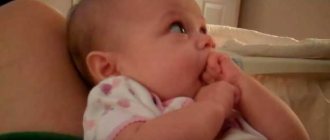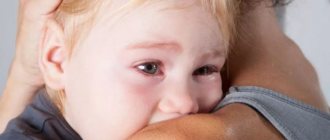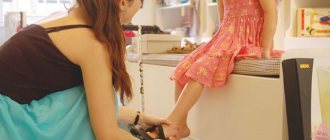Causes of cold hands and feet in a baby
The fact that a baby was born (even naturally without additional stimulation) does not mean that his body is ready to live in the big world. During the first few months, adaptation to new living conditions occurs. Thus, the thermoregulation system of a child’s body is relatively normalized only by 3 months, and is fully stabilized only by 18 months. Before this, “failures” are quite possible. The body temperature of a newborn baby will quickly respond to climate change (in particular, when leaving the room to go outside and back) and even to hunger.
It is important to remember: it is much easier to overheat a baby than to freeze it.
If the baby is cool, he begins to get nervous, scream, move his legs and arms - all these actions generate energy that is converted into heat. This way the baby warms itself. If the baby is hot, he will also mope and move actively, but in this case the body temperature will only increase.
So, the main reasons for cold feet and hands of a newborn:
- imperfection of the thermoregulation system;
- low air temperature;
- lack of iron in the body;
- disorders of the thyroid gland;
- initial stage of the disease.
The most difficult thing for parents is to determine the true cause of the baby’s cold extremities. Sometimes you don’t need to do anything about it - after all, there are adults with constantly cold hands. But sometimes this is a signal of a problem, the solution of which should not be put off for a long time.
Physical exercise
Situation one: physiological response to physical activity. We are talking about a healthy baby, cheerful, active, and not complaining of deterioration in health. The air temperature is within normal limits, as recommended by Dr. Komarovsky, there are no drafts, but the child’s feet and palms have become colder than the rest of the body.
What is happening is the result of physical activity, which is understandable from a physiological point of view. During games and sports competitions, the child feels passion and excitement.
At this time, muscle work stimulates the release of adrenaline, a hormone synthesized by the adrenal cortex. Adrenaline causes a rush of blood to the vital organs - the heart, lungs, and brain. In turn, blood drains from the skin, the blood vessels spasm, and the temperature of the skin drops.
What to do? If, after the child calms down, the hands and feet become warm without additional measures, then the situation is considered normal and does not require any additional measures. This is a physiological feature of children and there is no need to look for pathology.
Internal factors
We have already talked about thermoregulation. The golden rule for parents: in cold weather, you should dress your baby one layer warmer than you, and in warm weather, one layer lighter. And at a temperature of 21-25o C, you can dress the baby like yourself. A simple test will help you accurately determine whether the reason lies in the fact that the baby is cold: you need to touch the baby’s chest with the back of your hand. If it is cool, the baby is really cold. The right choice of clothing will help the child’s body respond more adequately to the microclimate.
Sometimes it happens that a child’s body experiences a lack of iron. You can check this with a routine blood test, determining the level of hemoglobin in it - from 110 units or more. Iron deficiency leads to anemia of the extremities, which also affects their temperature. The reason for low hemoglobin is poor nutrition (or poor nutrition of the mother if the baby is breastfed), dysbacteriosis and even premature birth.
There are often cases when a malfunction in the body’s temperature regime comes from the thyroid gland. In addition to cold hands and knives, another obvious sign appears: regular constipation. And also - thickening of the tongue. If you have these symptoms, you should definitely contact an endocrinologist - it is the doctor of this specialty who examines and treats the thyroid gland.
What determines the temperature of the arms and legs?
There are many factors on which the temperature state of the upper and lower extremities of infants depends: this is the ambient temperature, the state of the baby’s autonomic nervous system, and even whether the baby is full or hungry. In the first months of their little life, toddlers do not yet know how to “keep” their body temperature, so advice on insulating a small family member should be taken with special attention if the room where the newborn is located is not protected from drafts, and if the temperature in it is below the required 22 -25 degrees.
But why a baby has cold hands and feet when he is at least a month old should be investigated immediately. And it’s better not to do this yourself, but to involve a pediatrician in this.
Onset of the disease
A change in the temperature of the legs and arms may be the first signal to the mother that there is a disease in the body. Therefore, if you discover that your hands have suddenly become cool, you should carefully examine the rest of the body, and generally pay attention to the behavior of the baby. Maybe he lost his appetite, became very moody, or developed rashes on his body? Any of these signs requires calling a pediatrician - it’s better for the doctor to examine the baby and make sure that everything is fine with him, rather than waste time, which will allow the disease to develop more strongly in the child’s body.
Moreover, the disease can be either viral or cold. If you learn to “read” signals from a child’s body, this will help you take timely measures to eliminate problems.
If the baby develops a fever, but the legs and arms still remain cold, the pediatrician will most likely prescribe an antipyretic along with a vasodilator and antihistamine. You can also do a light massage on your hands and feet to get the blood flowing. But under no circumstances should you rub your baby with water or, especially, vodka! This folk, “grandmother’s” method is fraught with more health risks than benefits from its use.
To bundle up or not to bundle up? That is the question…
As soon as a baby is born in a family, parents, despite reading the literature and watching programs related to raising and caring for children, have a lot of questions regarding the health of the little one. And one of the most frequently asked questions is: “Why does the baby have cold hands?”
The first thing mothers do in this case is to try to warm him up as quickly as possible by wrapping him in a blanket. This is what many young parents do. And the older generation is firmly convinced that the best and most effective remedy is to dress the baby in woolen mittens and socks, even if his legs and arms are only cool.
As a rule, doctors try to assure new parents that if the child has a good appetite and calm behavior, there is nothing to worry about. Modern pediatricians recommend paying attention to the general condition of the baby, because his cold arms and legs can be both evidence of a normal condition and a signal that the baby has some kind of disease.
...And a few more recommendations
To know for sure that the cause of cool extremities is the development of thermoregulation, you can take simple measures to eliminate other possible causes. So, you can put on thin socks and anti-scratch socks for your baby, feed him exclusively warm food (and if supplementation is practiced, then also warm water). Every day you need to do light exercises in the morning, and massages in the evenings, after swimming.
And, of course, hardening: when changing a diaper, 15-minute air baths will not hurt, which will allow both the skin to breathe and the body to better adapt to the environment. A contrast bath will also be helpful. But a children's contrast bath is significantly different from an adult's: after bathing the baby in water at a temperature of 38°C, he needs to be doused with water at a temperature of 36°C. For us the difference is not significant, but for the child’s body it is quite effective.
In any case, if you notice cool feet or palms, do not worry. If you can’t find the cause on your own, you can contact your pediatrician and find the cause together. For most babies, this is a normal state, and therefore parents will often notice that the baby’s arms or legs have become cool.
When to sound the alarm
Cold hands in a child can be one of the symptoms of a cold. In this case, in addition to cold hands and feet, the child also experiences an increased body temperature.
In addition to temperature, there may also be:
- Snot and cough;
- Rash on the child's body;
- Refusal to eat, vomiting or frequent regurgitation;
- The child is capricious and cries for no reason.
In all these cases, it is better for you to contact your pediatrician so that he can examine your baby and give you qualified advice that relates specifically to your case.
It is also worth mentioning here that one of the reasons for impaired thermoregulation may be a disease of the thyroid gland. So keep that in mind too.
How to rid your baby of cold hands?
To try to solve such an important problem as a baby’s cold hands (and his feet too), it is necessary to carry out a number of preventive measures. If it's all about blood circulation, then a course of massage at home or in the hospital is necessary. Such a massage, concentrated on the little one’s body and limbs, will strengthen his muscles, activate blood circulation and give the baby a boost of energy. Blood will circulate better throughout the body, flow better to the limbs and supply tissues with oxygen. And certain massage gymnastics will give the baby’s body flexibility.
Thanks to the contrast shower, the blood vessels expand, which also improves the circulatory system. Such hardening, moreover, strengthens the baby’s immunity from childhood. After the shower, you need to intensively rub the little one with a soft towel, which will ensure a rush of blood to the legs and arms and, accordingly, they will become warm.
Important to remember! The baby must always be warm, so you need to make sure that his clothes are of high quality. You should not wrap your little one up too much, so as not to cause heat rash and increase his temperature. But be sure to dress him in more than one layer of clothing, which will be one size larger.
In many ways, the temperature regime also depends on the food consumed by the baby. Mom should make sure that the food is a little higher in degrees than room temperature.
It is imperative to protect the little one from stress, because the nervous system of children is too sensitive to any shocks. If her work goes wrong, this will cause not only cold hands and feet of the toddler, but also many other serious pathologies.
What should parents do if their child is cold?
If you find that your child's body temperature is low, help him warm up. Make sure your baby's clothes and bed are warm and dry, and provide him with plenty of warm drinks. If your child has cold feet, you can apply a warm heating pad to them.
Monitor your child's temperature carefully. As the baby warms up, she will return to normal. If shortly before this the child was treated with antipyretic or vasoconstrictor drugs, then in the absence of any other alarming signs it is enough to provide him with comfort and warmth. After some time, the temperature returns to normal on its own.
When a child has a low body temperature for a long time or occurs frequently without any apparent reason, it is necessary to be examined by a doctor. Remember: a low temperature can indicate the development of a variety of pathologies and diseases, and the sooner its cause is found, the lower the risk of serious problems with the child’s health.
Rate this article: 3.56 3.6 out of 5 (25 votes)










